Dental Costs for Gum Disease – Save and Heal Faster
Periodontitis, or Gum Disease, can be an extremely dangerous and painful condition. So, what is the cost to treat Gum Disease?
The cost to treat Gum Disease will vary, depending upon, amongst other things, its’ severity.
A Dentist can treat your Gum Disease from $95 – $172.
However, if your gums have gotten really bad, you may be referred to see a specialist (a Periodontist), who may charge you up to $4000.
This blog will cover all your options for treating Gum Disease, and how much they will cost;
- What Are the Item Codes for Treating Gum Disease?
- Are There Alternative Treatments that are Cheaper?
- What Are the Costs in Each State
- New South Wales Gum Disease Costs
- Victoria Gum Disease Costs
- Queensland Gum Disease Costs
- Western Australia Gum Disease Costs
- South Australia Gum Disease Costs
- Tasmania Gum Disease Costs
- Australian Capital Territory Gum Disease Costs
- Northern Territory Gum Disease Costs
- Do You Need to Visit a Periodontist?
- Are Periodontists More Expensive, and By How Much
- Can You ‘Self Treat’ Gum Disease for Less?
So, let’s get straight into it.
What Are the Item Codes for Treating Gum Disease?
The Item Codes (that is, the three-digit code number assigned by the ADA for all dental procedures) that are relevant to treating gum disease are listed below.
Item 213 – Treatment of Acute Periodontal Infection
This procedure is the treatment of severe and painful periodontal infection(s), and may involve;
- Removing calculus from the infected tooth/teeth or implant.
- Drainage of pus.
Not all cases of gum disease are this serious. An Acute Infection means that your body is not handling the Periodontitis.
Symptoms include when you have;
- Swelling of your gums and lymph nodes.
- Pus emerging from between your teeth and gums.
- An extruding tooth or teeth.
- Gum tissue that is coloured red or a deep red-blue.
- A fever or feel fatigued.
- A sensitive area around the infected tooth, which is especially noticeable when you bite.
- A metallic taste in your mouth.
There are two common types of Acute Periodontal Infections
A Periodontal Abscess
This is caused by a gathering of pus accumulating in your periodontium (the structure that supports your teeth) and forming an abscess.
This will need an emergency treatment, which involves;
- Applying anaesthetic to the infection.
- Draining the infected area, by putting a sharp curette into the bottom of the abscess.
- This will clean the deposits of plaque and calculus from the surface of the root.
- You may be given antibiotics.
- You will be told to use chlorhexidine mouthwash.
- You will have a follow-up appointment in 2-4 days, and another in 1 week, so the Dentist can observe the result of the abscess.
If the surface if the root has become too hard to remove, you may need periodontal surgery. This will minimise the risk of the abscess coming back.
Acute Necrotising Ulcerative Gingivitis (ANUG)
ANUG will swiftly destroy your gum tissue.
It is a complicated gum disease, as the exact cause it is yet to be established.
Although generally self-limiting, it can expand all over your gums.
It leads to unprompted bleeding, halitosis, and is highly painful.
Apparent causes for ANUG include;
- Poor oral health and diet.
- Overcrowded teeth.
- Smoking cigarettes.
- The build-up of calculus.
- Stress, and
- Imbalanced hormones.
It too requires emergency treatment, though this can be difficult due to the painfulness of the disease.
However, this is still necessary to get rid of bacteria, and involves;
You can expect to pay anywhere from $100 – $172 per visit for this treatment.
- Providing local anaesthetic to the infected area.
- Taking care to tenderly remove the damaged tissue, using ultrasonic and hand tools.
- Antibiotics are usually given. You should be told to use chlorhexidine mouthwash.
- A follow-up appointment will be made for 1 week later, to check-up on how the gums have healed.
- At this appointment, you will be given more advice on cleaning your teeth and gums and dental hygiene.
Item 221 – Clinical Periodontal Analysis & Record
This procedure takes place at the same time as Item Code 222 (see below).
It is a specific analysis that takes place when diagnosing and managing periodontal disease.
It involves;
- Thoroughly examining and evaluating your gums, in order to manage your gum disease.
- Keeping a record of your periodontal state, so there is history showing the health of your gums, any bone loss, etc.
You will pay on average $56 – $84 for this procedure.
Item Code 222 – Root Planing and Curettage (per tooth)
This involves the mechanical removal of biofilm and calculus from a tooth with gum disease.
It will bring it back to a level that is in accordance with proper periodontal health.
The health of your gums should always be attained by using, if possible, the most non-invasive and inexpensive methods.
Many times, this is achieved by using Root planing and curettage, which is a non-surgical treatment. It involves;
- Detailed cleaning, which removes the build-up of plaque and calculus caused by bacteria beneath your gum line.
- Carefully cleaning the surfaces of your roots, removing plaque and calculus rom your deep periodontal pockets.
- ‘Planing’ your teeth – smoothing the surfaces of the roots, which prevent bacteria, plaque and calculus from refastening below the gum line.
- Giving the gum tissue time to heal, before reattaching the tooth.
- You may be given antibiotics or antimicrobials. These assist in controlling the growth of bacteria that made the toxins, which lead to the periodontitis.
You will possibly require ongoing maintenance, such as further removal of calculus.
On average, you will pay roughly $95 – $163 per tooth.
Are There Alternative Treatments that are Cheaper?
There are not so many alternative treatments that are cheaper.
As I will discuss under the sub-heading “Do You Need to Visit a Periodontist” below, you may instead be referred to see a specialist.
This specialist, known as a Periodontist, will charge more than a Dentist.
However, a general Dentist will not go to the same level of depth to treat your gum disease as a Periodontist will.
This is as a Periodontist is a specialist in gum disease – a field known as “Periodontics”.
A Periodontist, for example, will sort of pull away from the gums. They will then clean under them and stitch them back up.
Whereas a Dentist will just get into your gums with a laser and make sure that all the debris is cleaned off.
So, a Periodontist will have a detailed and personalised plan for treating your Gum Disease.
They will also have all the latest, most up-to-date techniques to treat your Gum Disease, and any other periodontal problems that you may have.
What are the Costs in Each State
Depending on the state or territory in which you live, the average price for treating gum disease will difference.
I will now show you the range of costs across Australia, as per annual surveys done by the Australian Dental Association (ADA).
Do You Need to Visit a Periodontist?
You only need to visit a Periodontist if you are referred by your Dentist.
A Periodontist is a specialist who deals with gums and treats Gum Disease.
Your Dentist will only refer you to see a Periodontist if your gums have gotten really bad, such as if they have gotten to the point where they need grafting.
Feel free to read our post – Periodontal Treatment: Why You Need to See a Periodontist if you need more information on the topic.
Are Periodontists More Expensive, and By How Much?
Yes, a Periodontist is a lot more expensive than a Dentist.
For example, a Dentist will charge $200 per quadrant to perform a deep clean.
In the dental world, a quadrant is when they split your mouth into four sections or quadrants. So, each quadrant has eight teeth or less.
Where a Dentist charges $200 per quadrant, so $800 for the whole mouth, a Periodontist will charge closer to $4000 to perform the whole procedure.
Can You ‘Self Treat’ Gum Disease for Less?
There are no successful ‘self-treatments’ for gum disease.
We have known cases of clients using;
- Coconut oil, or
- Saltwater.
Whilst these have helped settle the disease for a short period of time, in the end, patients have lost a tooth.
You see, what happens with gum disease, is, if you do not see a Dentist and receive treatment, all the plaque and tartar will get stuck.
Nothing is going to get that off unless you get it scraped off. It will actually end up eating away at your bone.
So, you cannot successfully treat it at home. Once this damage has been done to the tooth, you cannot reverse it.
I do not suggest that you try, as you could end up with a huge infection, and the outcome of this will not be good.
Conclusion
Gum Disease (also known as Periodontitis) can vary greatly in its’ severity.
A Dentist may be able to treat your condition from $95 – $172.
However, if your condition has gotten extreme, you may be referred to see a Periodontist – a specialist in treating gum disease.
You do not need to visit a Periodontist unless referred by your Dentist. They will charge a lot more than a Dentist for the same procedures – up to $4000.
If referred though, it is worth paying these costs, as they will go to greater lengths to treat your Gum Disease.
Please know that there are also no known cases ‘self-treatments’ that work – though coconut oil or saltwater may help momentarily, they will not cure the condition.
Instead, the plaque and tartar will remain stuck on your teeth and eat away at your bone, which can cause infection(s) and may result in tooth loss.
We hope this article has helped you understand how serious Periodontitis can be.
If you have any questions on Gum Disease just reach out to Dr V
By Anthony Cade
Created at October 28, 2020, Updated at January 25, 2025
Sorry, the comment form is closed at this time.


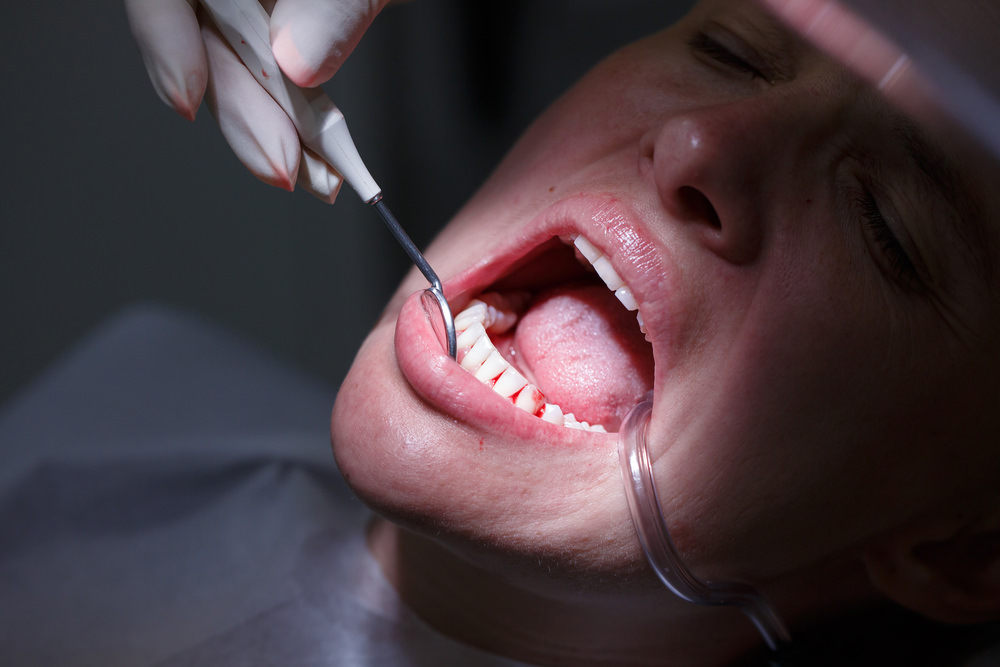
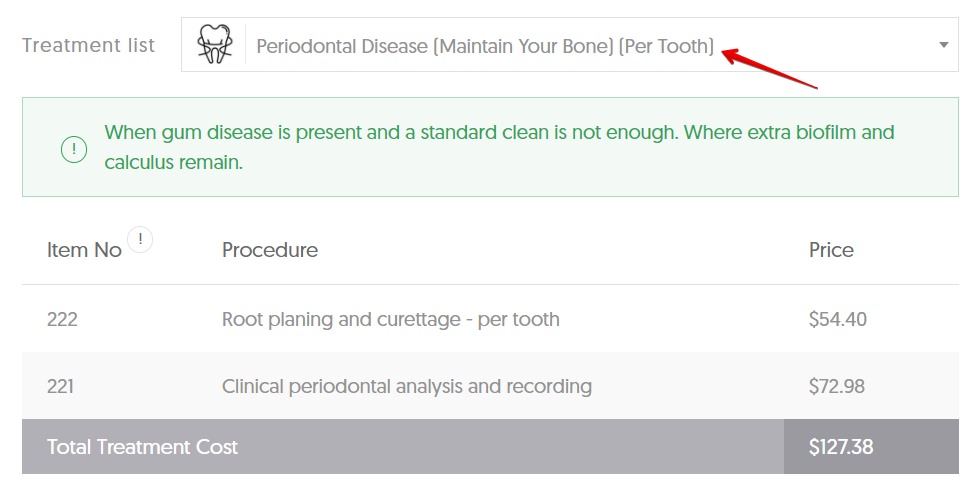
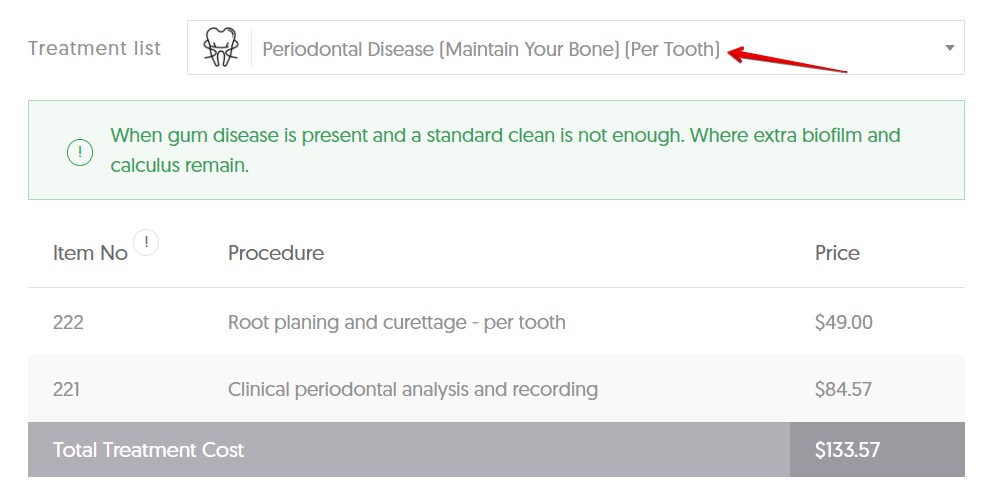
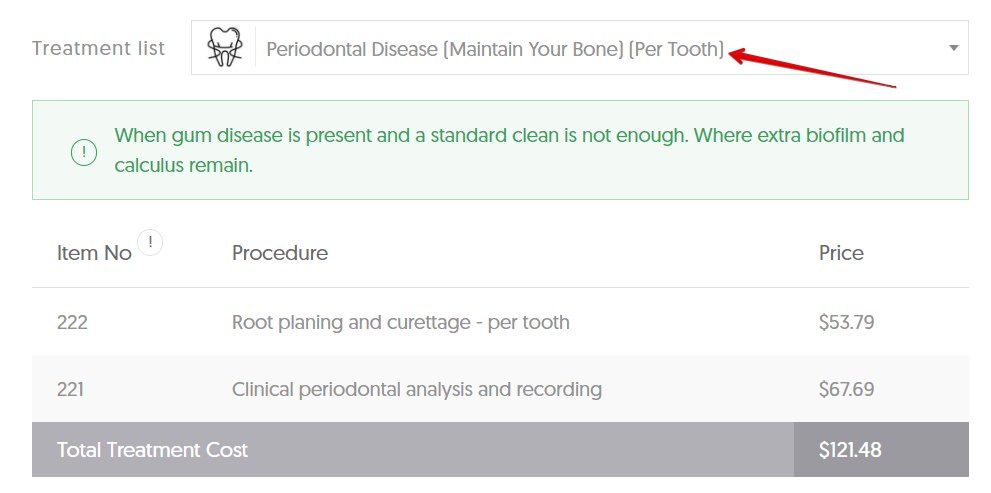
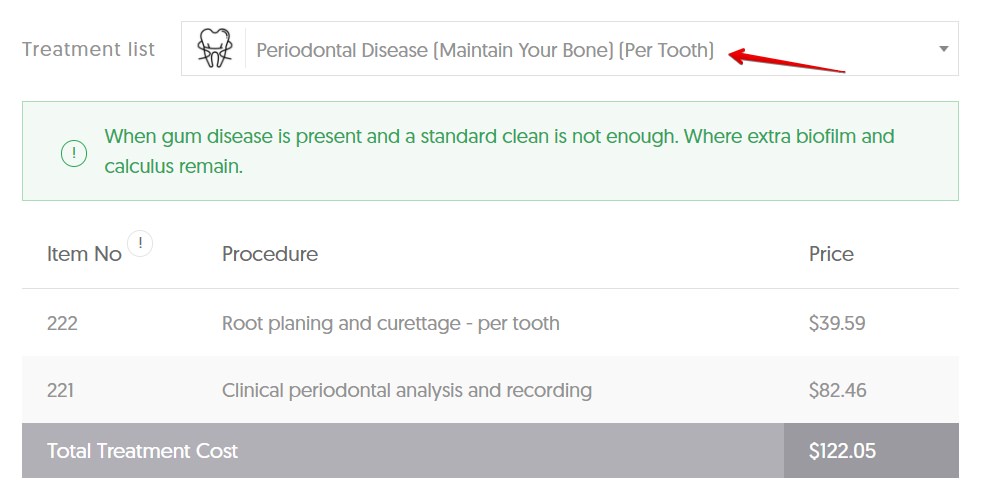
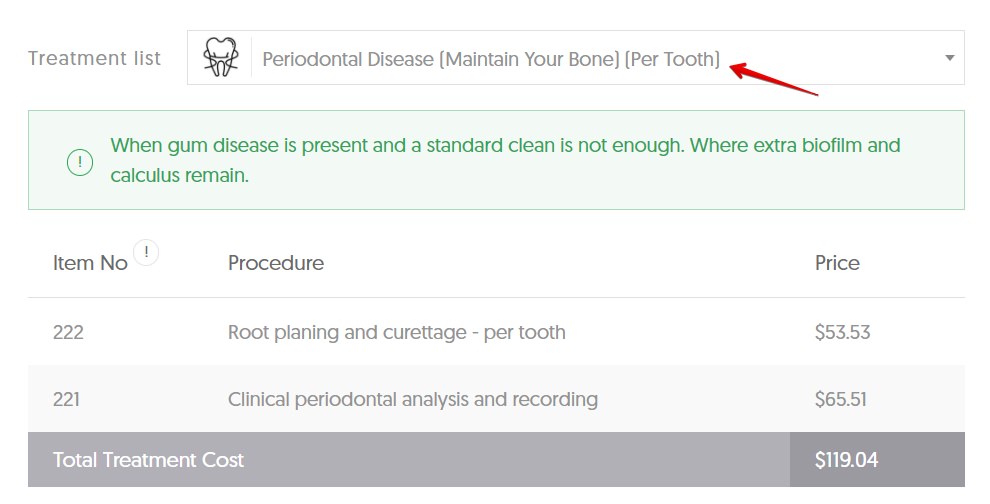
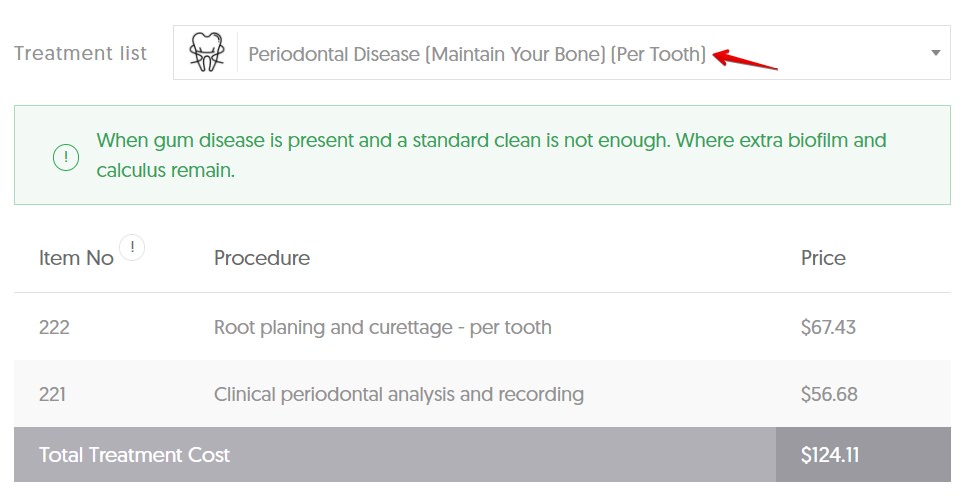
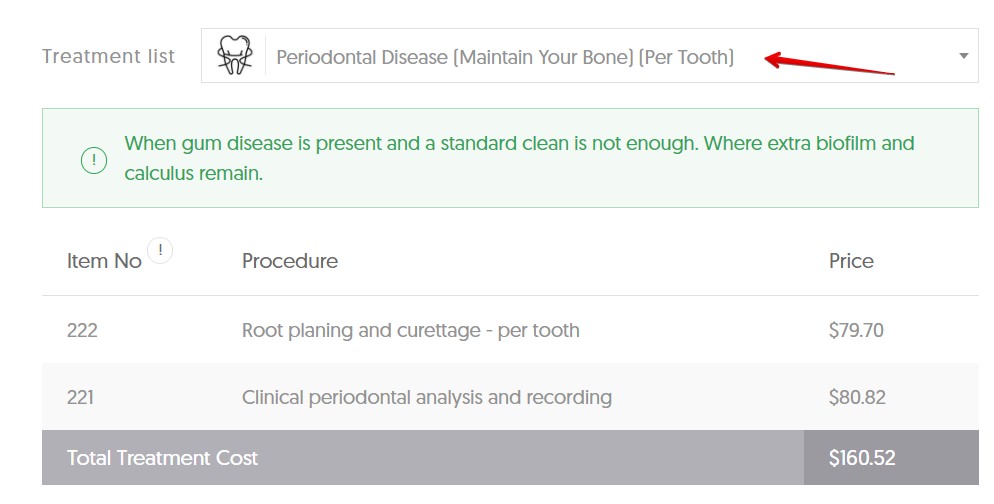
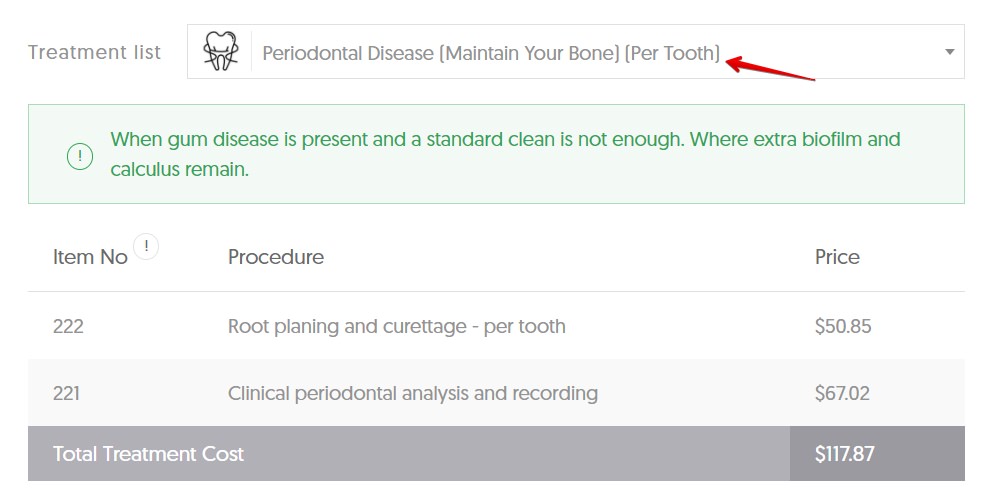


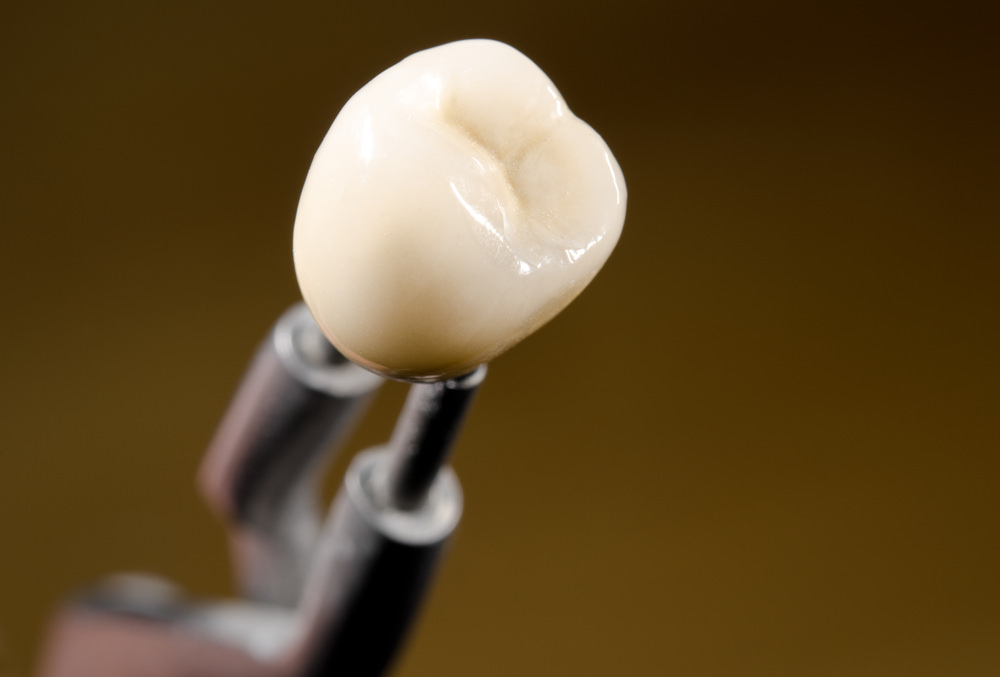
Connor Wong4 years ago
Hi Dr V,
Thank you for this amazing website. I wish I would have come across this website before receiving treatment for the gum disease. So far, I have extracted 8 tooth (inc wisdom), tooth filling, splint for grinding and 2 visit to the local periodontist for root planning. I was told that I need an ongoing root planning session and of course I do intend now to shop around.
I would like to enquire, with the calculator, is the item number 221 a once off for 24 tooth (I only have 24 tooth)? Meaning (item number 221: $82.46) + (item number 222: $39.59 x 24) = $1,032.62
OR
(Item number 221: 82.46 + item number 222: 35.59) x 24 tooth = $2,833.20.
If you don’t mind, I would also like to enquire on tooth removal. As said I had 8 tooth removed recently. Is item number 013 and 022 a once off for 8 tooth or is it per tooth. I removed all 8 at the same time. The reason I would like to ask is to confirm if my dentist has been reasonable with his charges.
I appreciate the effort to reply.
Sincerely
Connor
Dental Aware Team4 years ago
Dear Connor
Yes, often dental treatment can be confusing.
The different health funds have different options and rules so with the item numbers
I will try to tell you what they are so that you have an insight when you are being charged.
221 is Periodontal charting…Gingiva is the superficial gum which is not attached to a tooth.
However, the periodontal ligament is attached to the root of the tooth. If the periodontitis is not treated
the attachment of the periodontal ligament can be lost. So the charting can be done the first time
but it must be done periodically with time to ensure that you have not lost any more of the attachment of the periodontal ligament
to the root. This must be an ongoing thing…The number of times you can claim has to be discussed with your
health fund.
Item 222 is deep scaling and root planing per tooth.
This is also subjective to the health fund limits.
If you use Hydrogen peroxide 3% (buy from the Chemist or supermarket). Use the hydrogen
peroxide at least once a day to rinse after debridement in relationship with your debridement at home
please use Piksters (again buy from chemist or supermarket).
After treatment what your main aim is to attach the periodontal ligment to the root of the tooth and keep
the ligament healthy. Hydrogen peroxide delivers oxygen to the tissues and actually does eliminate
the bacteria which are destructive to the periodontal ligament.
Other factors which affect the health of your periodontium
1. Genetic. The genetic factors gives you a gun but your lifestyle and environment pulls the trigger.
2. Crucial that your diet is mainly “alkaline” use Google to see the foods which can achieve this. Disease
Loves acid and every time you eat sugar or processed foods…this promotes an acidic environment.
3. Debridement is crucial that you clean the spaces between the teeth
4. Mouth breathing is really drying to the mouth and promotes bacteria which is destructive. Snoring at night can promote mouth breathing. It is really important that you learn to breathe through the nose. Get “nose cones” (buy online..eBay is great) this will promote nasal breathing at night
5. Acidic environment and reflux from your stomach may be promoting an acidic environment in your mouth.
6. Occlusal trauma. If you are grinding and clenching this is really worth looking into so that the forces of mastication are equally distributed and that excessive force is not placed on any single teeth
Without making this email complicated I hope that I have answered your questions.
The main factor which I did not add above is definitely “SMOKING”. The simple choice is
you can have smoking or teeth. Sorry to be blunt but with my years of experience not many have
been able to break this rule…actually I don’t think I have seen any patients who do not eventually succumb to
periodontitis who smoke.
With my kind regards
Dr Veronica Roller
Treena4 years ago
What do peradontists charge for all on 4 top teeth and also bottom set
Andrew Adams4 years ago
Hi Treena, Thanks for reaching out to us. Each periodontist charges different amounts so it is best to select a few and call around. Google reviews can help here as well. You will be able to narrow your search down this way and get direct information from each if you require it. Kind regards, Andrew Adams Dental Aware
jacs2 years ago
Hi Andrew, thanks for such an informative website
I have an old root canal (over 20 years) on one front tooth which i inadvertently pushed forward by biting on a peach kernel. Now the tooth is loose and elongated but still in socket.
My aim is to save my natural tooth (no crown/no veneer). I might have some tooth bone loss. Who is better to see a n endodontist or periodontist?
Also I have heard laser surgery eg LANAP is much better than traditional surgeries.
Can you suggest any periodontists (if bone graft is needed) who are certified and approved to use such technology?
Many Thanks Jacs
Dental Aware Team2 years ago
Hi Jacs,
Unfortunately I am not able to suggest any periodontists but I will ask around and come back to you with any recommendations. Thanks
Jude Lancaster2 years ago
Hi
My dentists had quoted me 6k to remove plaque/Tartar up under my gums. ( apparently all teeth will be done)My gums bleed a little when brushing so obviously a symptom of gum disease. No other symptoms though . My dentist says he does not need to refer me to a periodontist ( as it is not severe). The cost includes twilight sedation. After doing some online research the amount quoted seems really excessive and reading your info above says periodontists charge up to 4K so I’m being quoted more than a periodontist charges. Can you shed any light? I’m in Sydney. The dentist took a 1k deposit for this treatment however I think I should see a periodontist and get their opinion.
Tana2 years ago
3 months appointment after full mouth periodontal debridement do I need to deep clean full mouth again or just deep clean the tooth with gum disease?
My dentist said it will deeper than normal clean but shallower than debridement(is it still counted as Item 222?). But she din’t explain whether full mouth or gum disease tooth only. Thanks.
Ben2 years ago
Could you tell me how much for periodontal maintenance appointment in VIC? Thanks.